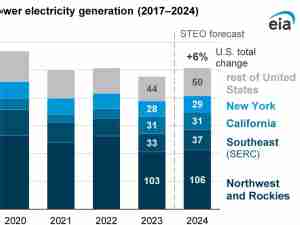US natural gas demand could be on track to hit record lows in January if unseasonably warm weather sticks around.
Despite consistently robust LNG demand – totaling around 7 million tonnes – particularly from European buyers, prices are falling and expected to continue bearish momentum until winter weather returns.
Gas production and feedgas deliveries have rebounded after a sudden drop due to Winter Storm Elliott in late December.
The frigid temperatures impacted production, predominately in the Northeast, with shut-ins from Appalachia further extending to the South Central and into the Midwest.
Production has recovered since the well freeze-offs and is now back close to 100 Bcfd.
The winter storm also pushed US feedgas deliveries to LNG terminals down about 27% to 9.3 Bcfd for the daily low, but nearly all facilities have ramped back up and are receiving close to 12.2 Bcfd.

A few pipelines and extensions are set to come online this year, with the Haynesville already off to a strong start.
Gulf Run is finally up and running, with completion in late December 2022 and initial flows on January 2 – a much-needed relief for Haynesville takeaway capacity.
However, of the 1.65 Bcfd total nameplate capacity, the pipeline will be capped at 0.5- 1.0 Bcfd levels until Golden Pass LNG and its’ connector pipeline is built.
Pipeline limitations result in the Permian starting 2023 with negative prices, but the tightness will ease as the year progresses.
The region is set to add just shy of 2 Bcfd capacity with the potential for three pipeline expansions in the second half of the year.
Price pressure is expected to continue until then.
On the demand side, the latest forecasts point to warmer weather ahead, with the start of 2023 well above average temperatures, reduced heating degree days (HHDs) and demand for gas in the coming weeks, overall signaling an improvement in market balances that have pushed US gas prices into the sub- $4.00/MMbtu range to levels not seen in over a year.
Uncertainty remains around when Freeport LNG will restart.
The operator announced a further extension to mid-January, but given the lack of clarity around the plant’s regulatory approval status, the timeline could be pushed out further, increasing downward price pressure.
Even with additional volumes in the domestic market from the Freeport LNG outage, strong year-end gas demand resulted in US storage withdrawals of 221 Bcf for the week ending December 30, 2022.
Supply losses due to Elliott-related well freeze-offs and strengthened demand for heating triggered the uptick in withdrawals.
Stock levels totaled 2,891 Bcf, nearly 10% lower than in 2022 and 6% lower than the five-year average.
Still, this week’s storage report is expected to be much lighter, with very minimal draws, on lowered demand last week and gains in gas production levels.








